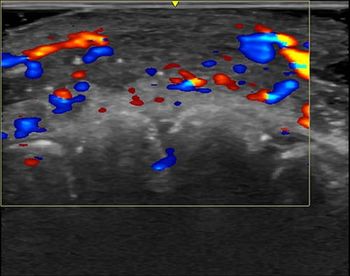
3D ultrasound speeds up monitoring of abdominal aortic aneurysms
Abdominal aortic aneurysms can be monitored more precisely and quickly using 3D ultrasound techniques than has been possible with 2D ultrasound. Researchers in the U.K. studied 30 consecutive patients with both methods and found almost no difference in the measurements of anteroposterior or transverse diameters. Three-D volume acquisition ultrasonography provided several advantages over traditional methods, however, including speed and the ability to compare new measurements with archived data.
Abdominal aortic aneurysms can be monitored more precisely and quickly using 3D ultrasound techniques than has been possible with 2D ultrasound. Researchers in the U.K. studied 30 consecutive patients with both methods and found almost no difference in the measurements of anteroposterior or transverse diameters. Three-D volume acquisition ultrasonography provided several advantages over traditional methods, however, including speed and the ability to compare new measurements with archived data.
Dr. Christiane M. Nyhsen and Simon T. Elliott, MB Chb, FRCR, of the radiology department at Freeman Hospital in Newcastle Upon Tyne published results of their study in the Journal of Ultrasound in Medicine. They used patients with known AAAs who were coming in for regular 2D ultrasound exams to monitor the size and stability of their aneurysms.
The patients were examined using standard ultrasound methods, then underwent 3D volumetric ultrasound to compare with their 2D results. Anteroposterior and transverse diameters of the aneurysms ranged from 2.9 to 6.75 cm. Nyhsen and Elliott examined the 2D and 3D sets of measurements with several statistical methods. The paired t test showed a Pearson correlation coefficient of 0.98 (where p = .01) and a coefficient of determination of 0.96. Bland-Altman analysis showed the mean difference to be very close to 0 (p = .05).
Two major advantages emerged in using 3D ultrasound to monitor abdominal aortic aneurysms. First, the technique takes only three seconds for each set of data: anteroposterior and transverse. This shorter scan time can help radiologists manage the increasing number of patients. Speed is especially important in countries such as the U.K., where national screening committees have recommended routine AAA screening for men over the age of 65.
The second advantage involves comparison of test results from one monitoring exam to the next. Data from 3D volumetric ultrasound tests can be archived and used the next time the patient comes in for a routine exam. This provides precise measurements of how the aneurysm has changed over time.
Newsletter
Stay at the forefront of radiology with the Diagnostic Imaging newsletter, delivering the latest news, clinical insights, and imaging advancements for today’s radiologists.




























